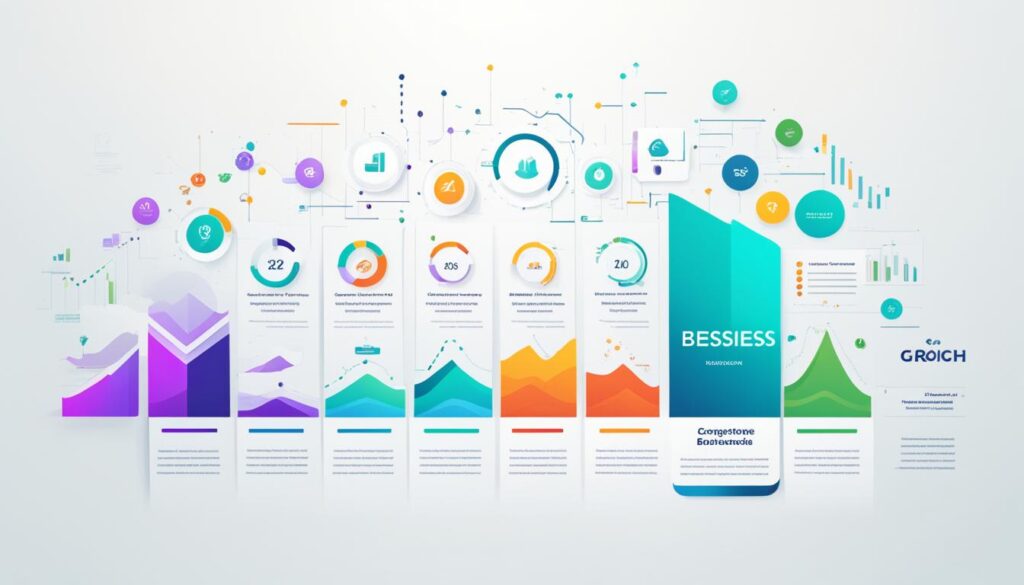When considering purchasing a business, one of the first questions that comes to mind is, “What types of businesses should I buy?” It’s essential to choose a business that aligns with your goals and has the potential for success in the market. To make an informed decision, it’s crucial to analyze various factors that contribute to a business’s viability and profitability.
Firstly, you should consider the industry trends. Look for industries that are experiencing growth and have a bright future. This ensures that there is a demand for the products or services offered by the business you are considering.
Market potential is another important aspect to evaluate. Research the size of the market and its potential for growth. A larger market signifies more opportunities for your business to thrive and expand.
Competition is also a significant factor. Identify the level of competition in the industry you are interested in. It’s advisable to choose a business that has a manageable level of competition, allowing you to have a significant market share.
Last but not least, profitability is crucial. Look for businesses that have a track record of profitability or businesses with the potential to generate profits. Evaluate the financial statements and projections to gauge the business’s financial health.
Key Takeaways:
- Consider industry trends, market potential, competition, and profitability when choosing a business to buy.
- Look for industries experiencing growth and a bright future.
- Research the size of the market and its potential for growth.
- Identify the level of competition and choose a business with a manageable level of competition.
- Evaluate the financial health of the business by analyzing financial statements and projections.
How to Measure a Business’s Potential
When it comes to buying a business, measuring its potential is crucial to ensure its success and profitability. There are several key factors to consider in this evaluation process:
- Market Size and Growth Potential: Assessing the size of the target market and its growth potential provides insights into the business’s scalability and long-term viability. A larger market with significant growth opportunities indicates a higher potential for success.
- Industry Competition: Understanding the competitive landscape helps determine the business’s ability to gain a competitive advantage. Analyze the number of competitors, their market share, and any unique selling propositions they offer.
- Barriers to Entry: Evaluate the barriers that prevent new entrants from easily joining the market. These barriers, such as legal regulations, patents, or high capital requirements, can limit competition and enhance the potential for profitability.
- Local and Global Market Trends: Stay informed about the current and projected market trends, both locally and globally. Changes in consumer preferences, technology advancements, or economic conditions can directly impact a business’s potential for growth.
- Adaptability to Economic Downturns: Consider how the business has historically adapted to economic downturns. A business that can withstand and even thrive during recessions demonstrates a robust potential for long-term success.
“Measuring a business’s potential requires a comprehensive analysis of various factors, from market size and growth potential to industry competition and adaptability to economic changes.”
– John Smith, Business Analyst
By carefully considering these factors, prospective buyers can assess the potential of a business and make informed decisions regarding their purchase.
| Factors to Consider When Measuring Business Potential | Importance |
|---|---|
| Market Size and Growth Potential | High |
| Industry Competition | Moderate |
| Barriers to Entry | High |
| Local and Global Market Trends | Moderate |
| Adaptability to Economic Downturns | High |
Industries with the Best Potential for Acquisition
When it comes to buying a business, some industries have greater potential for acquisition than others. These industries offer numerous opportunities for growth and profitability, making them attractive options for aspiring entrepreneurs. Whether you’re a first-time buyer or looking to expand your portfolio, understanding the best industries to buy a business in can significantly increase your chances of success.
One key factor to consider is the number of players in the industry. Industries with a high concentration of businesses indicate a thriving market with ample room for growth. Home services and certain professional services sectors, for example, have a significant number of businesses, presenting a wide range of acquisition opportunities.
In addition to industries with many players, it’s also possible to find profitable businesses in sectors with less competition. However, acquiring businesses in these industries may require deeper industry expertise or even a stroke of luck. It’s essential to thoroughly research and evaluate the potential of these lesser-known but lucrative industries.
Here’s a list of industries with the best potential for acquisition:
- Technology and software development
- Healthcare and wellness
- E-commerce and online retail
- Renewable energy and sustainability
- Food and beverage
- Manufacturing and distribution
These industries offer unique opportunities for growth and profitability, driven by market trends and consumer demand. However, it’s important to conduct thorough due diligence before making any acquisition decisions. Each industry has its own set of challenges and risks that need to be carefully evaluated.
By identifying industries with the best potential for acquisition, you can focus your efforts on sectors that align with your goals and expertise. Remember, a successful business acquisition requires careful analysis, strategic planning, and a deep understanding of the industry landscape.
The Importance of Having a Strong Moat
A strong moat is crucial for a business’s long-term success and profitability. A moat refers to the competitive advantages that protect a business from direct and indirect competitors. These advantages can include technology, licensing requirements, talent shortages, access to distribution channels, and high capital expenditures. Businesses with a strong moat are more attractive for acquisition as they have higher barriers to entry for potential competitors.
The presence of a strong moat provides a significant competitive advantage to a business, allowing it to maintain market share and fend off competition. This not only enhances the business’s value but also positions it as an attractive prospect for potential acquirers. With a strong moat, a business can achieve sustainable growth and establish a durable position within the market.
- Technological Advancements: Businesses with proprietary technology or innovative solutions have a distinct competitive edge. These advancements can create barriers to entry, preventing competitors from replicating the technology or catching up quickly.
- Licensing Requirements: Some industries have strict licensing or regulatory requirements, making it difficult for new entrants to establish themselves. This can provide existing businesses with a competitive advantage and increase their attractiveness for acquisition.
- Talent Shortages: Industries that require specialized skills or expertise may face talent shortages. Businesses that have a strong talent pool or established relationships with key individuals in the industry possess a moat that is hard to replicate.
- Access to Distribution Channels: Established businesses often have well-established distribution channels, giving them a competitive advantage when it comes to reaching customers. Access to an extensive distribution network can be a significant moat that contributes to a business’s long-term success.
- High Capital Expenditures: Industries with high capital requirements act as a barrier to entry for potential competitors. Businesses that have already made substantial investments in infrastructure, equipment, or manufacturing facilities have a competitive advantage over newcomers.
Having a strong moat is not only beneficial for the current operations of a business but also enhances its value as an acquisition target. Acquirers are attracted to businesses with sustainable competitive advantages as they provide a higher likelihood of continued success and growth.
When considering the acquisition of a business, evaluating the strength of its moat is essential. Understanding the competitive advantages it possesses can help determine the long-term viability and potential growth opportunities of the target business.
| Advantages | Description |
|---|---|
| Technological Advancements | Create barriers to entry |
| Licensing Requirements | Regulatory barriers |
| Talent Shortages | Exclusive access to skilled individuals |
| Access to Distribution Channels | Reach customers effectively |
| High Capital Expenditures | Barriers to new entrants |
A strong moat provides businesses with a competitive advantage that sets them apart from their competitors. It ensures long-term sustainability and profitability, making them an attractive proposition for potential acquirers seeking opportunities with higher barriers to entry.
Investing in Recession-Resistant Businesses
During economic downturns, it is crucial to make strategic investment decisions that can withstand the challenges posed by recessions. One such strategy is investing in recession-resistant businesses. These are businesses that have proven to perform well, even during periods of economic uncertainty. By focusing on industries that exhibit resilience and stability, investors can minimize the impact of economic downturns and maximize their chances of success.
There are certain industries that have proven to be recession-resistant, meaning they are less susceptible to the negative effects of economic downturns. These industries tend to cater to essential needs and have a consistent demand regardless of economic conditions. Some examples include:
- Home Services: Regardless of the economic climate, homeowners will always require repairs, maintenance, and improvements to their properties.
- Healthcare: Healthcare services are essential, and the demand for medical care remains relatively stable, even during recessions.
- Essential Goods: Everyday products such as food, toiletries, and household items are always in demand, making businesses in this sector less vulnerable to economic downturns.
Investing in recession-resistant businesses offers several advantages. Firstly, these businesses are less reliant on consumer optimism, making them more resilient to fluctuations in consumer spending. Additionally, recession-resistant businesses often have the ability to adjust their business models and scale their workforce based on demand. This flexibility allows them to adapt to changing market conditions and maintain stability even during challenging times.
Furthermore, investing in recession-resistant businesses provides investors with a sense of security. While no investment is entirely risk-free, these businesses have demonstrated their ability to weather economic storms and come out stronger on the other side. By allocating capital to recession-resistant businesses, investors can mitigate the impact of economic downturns on their overall investment portfolio.
Key Takeaways:
Investing in recession-resistant businesses is a prudent strategy during economic downturns. These businesses have proven to be more resilient to the negative effects of recessions and offer stability and potential growth even in challenging times. By focusing on industries such as home services, healthcare, and essential goods, investors can minimize risk and increase their chances of success. The ability of recession-resistant businesses to adjust their business models and scale their workforce based on demand adds an extra layer of flexibility and adaptability, making them well-positioned to navigate economic fluctuations.
The Importance of Fixed Assets in Business Acquisition
Businesses with a high fixed asset base, such as equipment or vehicles, offer several benefits in the context of business acquisition. Firstly, acquiring a business with significant assets allows for tax advantages through depreciation. This means that the value of these fixed assets decreases over time, resulting in reduced taxable income for the acquiring business.
Furthermore, lenders also prefer businesses with strong asset bases, making it easier to secure financing for the acquisition. The presence of valuable fixed assets increases the collateral that can be used to secure loans, providing lenders with greater confidence in the business’s ability to meet financial obligations.
Moreover, businesses with high asset requirements create barriers to entry for potential competitors. The substantial investment needed to acquire and maintain significant fixed assets acts as a deterrent to new market entrants. This reduces competition, allowing businesses with substantial fixed assets to maintain a dominant market position.
Therefore, acquiring a business with a substantial fixed asset base offers advantages such as tax benefits, ease of financing, and reduced competition. These benefits contribute to the overall value and potential profitability of the acquired business.
The Benefits of Fixed Assets in Business Acquisition:
| Tax Advantages | Easier Financing | Reduced Competition |
|---|---|---|
| Fixed assets can be depreciated, resulting in tax savings. | Lenders prefer businesses with strong asset bases, making it easier to secure financing. | Significant fixed asset requirements act as a barrier to entry for potential competitors. |
Evaluating Profitability and Customer Lifetime Value
When considering purchasing a business, evaluating its profitability is crucial. Profitability refers to the ability of a business to generate profits and sustain financial growth over time. It is an essential metric that helps potential buyers assess the financial health and viability of the business they intend to acquire.
Each industry has its own average profitability range, influenced by various factors such as market dynamics, competition, and consumer demand. When analyzing the profitability of a business, it is important to compare it to the industry average to determine its performance relative to competitors. Businesses that consistently outperform the industry average are generally considered more desirable acquisition targets.
Additionally, understanding the concept of customer lifetime value (CLV) is vital in assessing the long-term financial prospects of a business. CLV refers to the projected revenue that can be generated from a customer throughout their entire relationship with the business. By estimating the potential revenue generated from each customer, businesses can gauge their overall revenue potential and make informed decisions about their future profitability.
Evaluating profitability and CLV together provides valuable insights into the financial health and potential of a business. A profitable business with a high CLV indicates a strong customer base and a sustainable revenue stream, increasing its attractiveness for acquisition.
Benefits of Evaluating Profitability and CLV
By thoroughly evaluating profitability and CLV, potential buyers can:
- Make informed financial decisions: Understanding a business’s profitability and CLV helps buyers assess the potential return on investment and make informed decisions about the acquisition.
- Identify growth opportunities: Analyzing profitability and CLV enables buyers to identify potential areas for revenue growth and formulate strategies to enhance profitability.
- Assess risk: Examining profitability and CLV helps buyers evaluate the financial risks associated with the acquisition and determine the business’s resilience to economic fluctuations.
- Validate business performance: Evaluating profitability and CLV provides buyers with concrete evidence of a business’s financial performance, increasing confidence in the acquisition decision.
“Profitability and customer lifetime value are key factors for evaluating the financial potential of a business. By analyzing these metrics, potential buyers can gain insights into a business’s ability to generate profits and sustain long-term growth. This information helps inform investment decisions and identify opportunities for optimization and future success.”
| Benefits of Evaluating Profitability and CLV | |
|---|---|
| Make informed financial decisions | Identify growth opportunities |
| Assess risk | Validate business performance |
Conclusion
In conclusion, buying a business is a significant decision that requires thorough evaluation and careful consideration. Assessing the potential of the business, analyzing industry trends, understanding competition, profitability, and customer lifetime value are crucial steps in the decision-making process. By taking these factors into account, entrepreneurs can make informed decisions and increase their chances of a successful business acquisition.
Industries with significant growth potential, strong moats, recession resistance, and high asset requirements are generally more attractive for acquisition. These factors provide a solid foundation for long-term success and profitability. Additionally, understanding the lifetime value of customers helps assess the financial viability of a business over time.
Remember, buying a business is a strategic investment that requires careful planning and analysis. By thoroughly evaluating these aspects and considering the industry and market trends, entrepreneurs can make well-informed decisions that align with their goals and maximize their chances of success in business acquisition.








